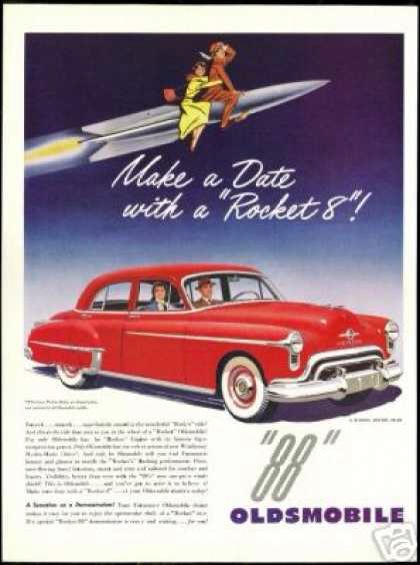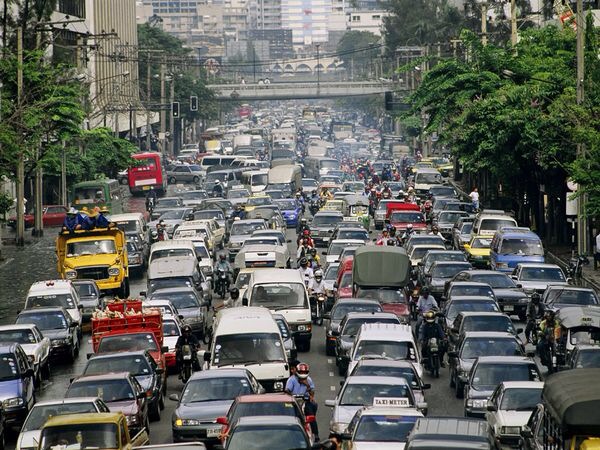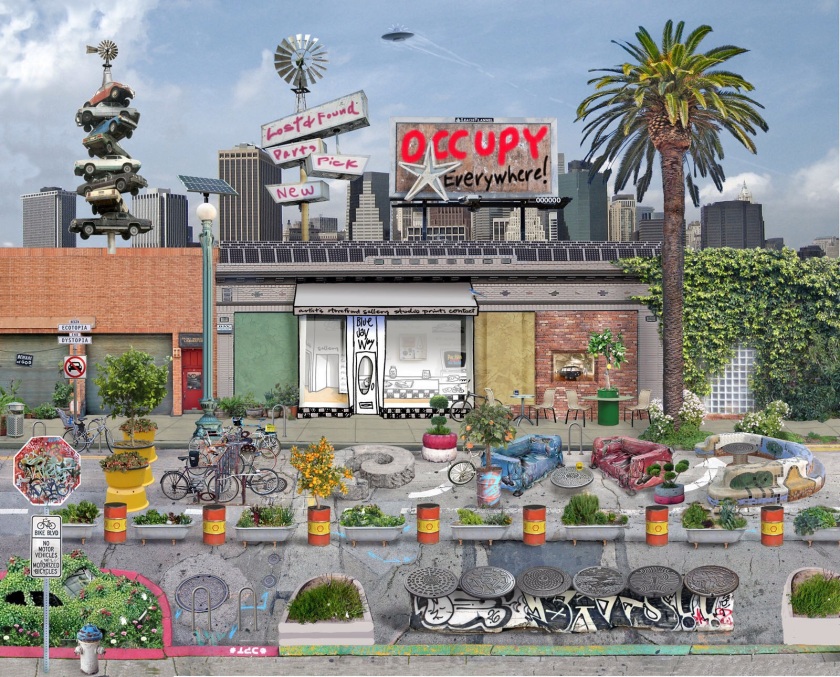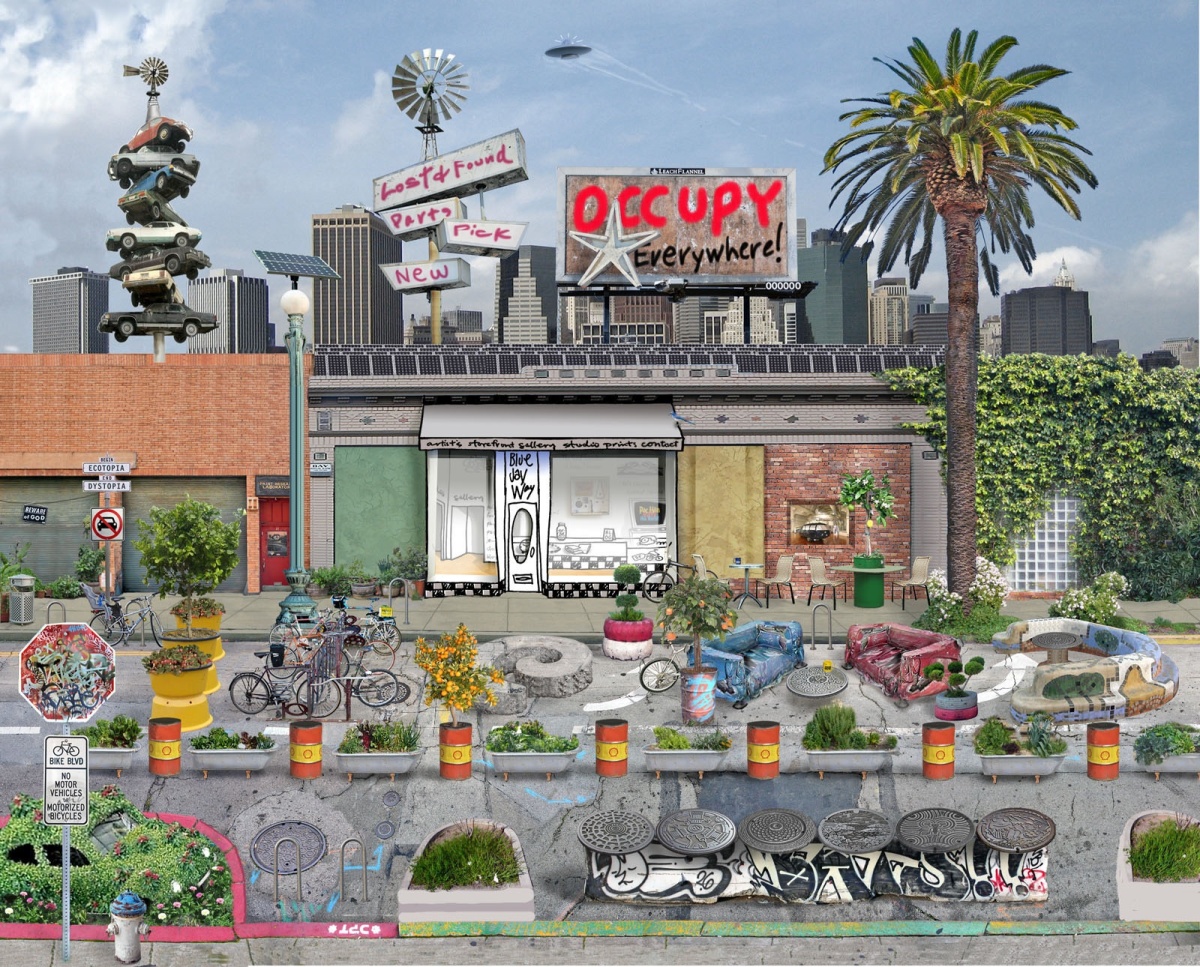Stepping out of the front door to my co-rented house, the streets are lined with cars packed into every available sliver of parking space. A common talking point amongst neighbors in passing is the parallel parking skills of a driver and how much space a car leaves for the next spot, front and back. I carry my small, blue one-speed bike (much too small for me, but cheap and easy to maintain) down the stoop and wade through two cars to get on the road. I bike up my street and almost without fail avoid one car before reaching the bigger street, where a row of speeding cars greets me in the far right lane. I get on the busy street constantly looking over my left shoulder and try my best not to simply trust the car drivers to avoid running me over. Thus begins the adventure of riding through the perilous city streets everyday.
Dodging giant chunks of metal speeding past me is the most immediate concern of my day. Screw up just once on the road and anyone: biker, car-driver, pedestrian, or skateboarder could end up dead. City and most suburban streets are dangerous places. The imperative that everyone who enters them act in a strictly predictable way, with any slight deviance from the norm putting so much at stake, makes everyone edgy. “Driving like a lunatic” puts everyone around you at risk but sticking your neck out and yelling out the window from the comfy confines of the driver’s seat is likely to arouse “road rage”. Our disposition can take a sharp turn from pacified (with your favorite tunes on and a temperature set perfectly to the degree) to incensed at someone who so blithely brought us so close to death. And such is life on the road: so casual and familiar a place, yet a place where we must also constantly straddle the line between tranquility and fury, life and death.


Stop on any street (on the sidewalk of course!) and look around you: you will almost always be able to locate about 30 cars just in your immediate sight. These vehicles are heavy and travel at a speed unheard of just 100 years ago (without tracks), and with just a gentle push from your right foot. The driver sits as they please and barrels from one side of the town to the other, transporting living bodies through a grid of straight lines and inside a steel cage. We control the car’s movements, but stand back and gaze upon the elegant mess of a city street and everything goes according to plan – if your lucky.
A car is sold as a commodity of freedom. Finally at the age to drive, we can now travel dozens of miles away without doing a lick of exercise and be alone, with our friends, or on a date. A car is a status symbol, one only briefly confined to one’s class in the first half of the twentieth century and now representing something purportedly more democratic: the freedom of the individual to travel to wherever it likes. The thrill of owning a car is sold as a ticket to the free life but also as an identity [Jeep’s 2009 ad campaign]. Unbound by your place of upbringing, you can now go to any-place your heart desires (the idea of ’anyplace’ being the main selling point vs any particular place) and deck-out your interior and exterior however you find stylish. With this one big purchase, the ritual is completed and the coming-of-age story closed. Now you’re off into the ’real world’ of the road.

Hiding in plain sight behind our now common sense notions of individuality and personal freedom is a sprawling world of metal objects zooming past each other at the distance of a few feet, a giant industry that created a new form of capitalist production [Fordism], and a rule-ridden “public space” where you either behave exactly according to geometrical lines on the ground and lights hanging in the air or risk fines and jail time. The police can and do pull people over whenever they want and can make up any reason to claim why they are doing so, “probable cause” being a flexible phrase that the police can always invoke by lying, then searching your car [When Can Police Search Your Car?]. Before going on, I feel it is important to note the shear dominance of the automobile and the roads its tires roll over on the daily life of an American. The concrete grids mapped onto the landscape must be maintained at tax-dollar expense (though mostly from, thankfully, a gas-tax [Transportation FAQ]) so that we can choose wherever we want to live and still get to work on time. These roads are not only dangerous and hurried, they are the place where we expend most of the carbon, threatening most life on the planet (only surpassed, perhaps, by our use of electricity indoors [EPA: Emissions by Sector], and interact with the most strangers. Unfortunately, the only time we give these strangers moving at different speeds second notice is when we collide, and that contact we make with them is often deadly [Car Crash Fatality Statistics]. To get past our fossil-fueled present and envision a sustainable future, we will have to imagine our roads otherwise than blank spaces only to be filled up by personalized cars.

Some cities are already embroiled in a war between cars and cyclists as shown in this documentary: [Bikes vs. Cars: War on Cyclists], and car driving will not go down without a fight. People are attached to these things and the convenience, status, and ’freedom’ they provide. Managing the reduction in car driving will be key to stopping runaway climate change and will have to be done with minimal outrage. Not only do alternatives need to be readily available in public infrastructure to travel long distances (which America is currently failing at epically [Last Week Tonight: Infrastructure]) but people will need to be able to live closer to their work and their family and friendship networks. This would ideally happen gradually, but this planetary problem has a time-limit; we only have so many years to plan for this change and one can only hope for fair warning. It’s hard for me to get over the expectation that family members have of being able to converge seasonally for celebrations and holidays while having moved so far away from each other. The good reasons we have for taking long car rides hide the decision to move so far away from each other in the first place, leaning on the car to whisk us back to see loved ones. We simply cannot make these long journeys (often worsened by jet-fuel) anymore without very low-carbon public infrastructure as an alternative.
People I talk to almost always bring up the prospect of electric cars and while this sounds appealing, there is a lot of energy that goes into making a car at the point of production [Carbon Footprint of a New Car], so some kind of renewable energy will be required to assemble them and gather all of the raw materials they require. Bicycles can be created entirely from bamboo, as some of the earliest ones were [Bamboo Bicycles]. It’s not unimaginable but I find it hard to believe that these electric cars could replace gasoline-powered cars one-for-one, especially thinking of where the electricity will come from when most electricity is generated by coal, which is worse than oil. It would be much easier to get everyone, by-and-large, to simply travel less, shorter distances, slower, and by low-carbon rail when necessary.
The planning of cities is a big culprit in this matter as well, and, to be quite honest, some cities just won’t function without cars and need to be abandoned [America’s Most Unsustainable City]. Many people simply need to own and drive a car to and from work because they live in the residential district which is on the complete other side of the city from the industrial, commercial, or financial district. This will have to change too, and the migration of people to houses closer to their work will have to be assisted instead of restricted by high rent and real estate bubbles. Many people have moved out of cities and into suburbs, who then commute long and tedious hours that almost nobody enjoys. A forewarning and assistance of some kind (be it state or otherwise) will be necessary for this massive transition in housing and transportation. If this seems too far-fetched and like central planning just consider the alternatives: do we really think that we can all collectively cover this much space in our travels everyday without the assistance of gase-powered automobiles?

The supply chains industry distributes all of the goods we consume via cargo-ship, seaports, airports, rail, and trucking – all using massive amounts of fossil fuels. Wind power has been used for thousands of years to transport goods by sea but, again, much slower and rail could be powered by other means. But trucking handles a great deal (~70%) of domestic and close range distribution [Logistics: Transportation Industry] and a different method must be found for getting goods to us from nearby. Why not paid bike caravans full of goods in their trailers traveling on car-less, roads? Without just-in-time logistics and with a better planned distribution system, we could afford to travel slower and in a big pack for the last short-distance leg of the chain ending at the market. Wouldn’t that be fun?
Some sectors just need to travel fast and will not negotiate: ambulances and fire trucks will need to be kept running. But this is not very difficult to deal with: with so few cars on the road, these fleets could easily be converted to electric power, itself powered by solar energy. In a nightmare scenario, the police would still be able to cruise in their cars while regular people could not. So let’s not let that happen.
All of this is merely a means to stimulate your imagination for what a sustainable future that is not at odds with the biosphere could look like. This blog post isn’t going to jump start a bill to send before congress. A good idea concocted recently has been solar roadways that would capture sun energy and use it to power nearby electricity needs and its own lighting [Solar Roadways Already Producing Energy] [Solar Freaking Roadways]. Yes, legislators, please try it.
We desperately need to be able to imagine how a society could work that doesn’t consume this much fossil fuel and excrete this much carbon into the air. Without the ability to see how it would work, what we would do differently, how we would get around, how we would relate to each other, etc. then we will fumble our words and remain locked in stunting fear or other sad affects. It hit me hard and gave me a glimmer of hope upon seeing an artwork done by my friend Sandy, who would ride his bike around Oakland with big posters glaring out at everyone who passed by. The posters were usually Occupy inspired art, but this one stands out as being a positive image of what a desirable future would look like:

And then there is this trend: [Millenials Reject Car Culture]
It is important to stay positive and creative, but until cars as the dominant for of travel are usurped, I’ll be getting pissed at every car that gets in the way of me and my beautiful, low-maintenance, exercise-giving, gas-less blue bike that costs nothing to park, rides nearly anywhere in the city, endangers next-to nobody, and doesn’t harm the biosphere. And I’ll be secretly pissed at every other car I see; secretly, that is, to decrease the chance I get killed by someone who got angry all-of-the-sudden and could only express that rage by pushing their foot on the gas petal. Everyday.


Reblogged this on My Desiring-Machines.